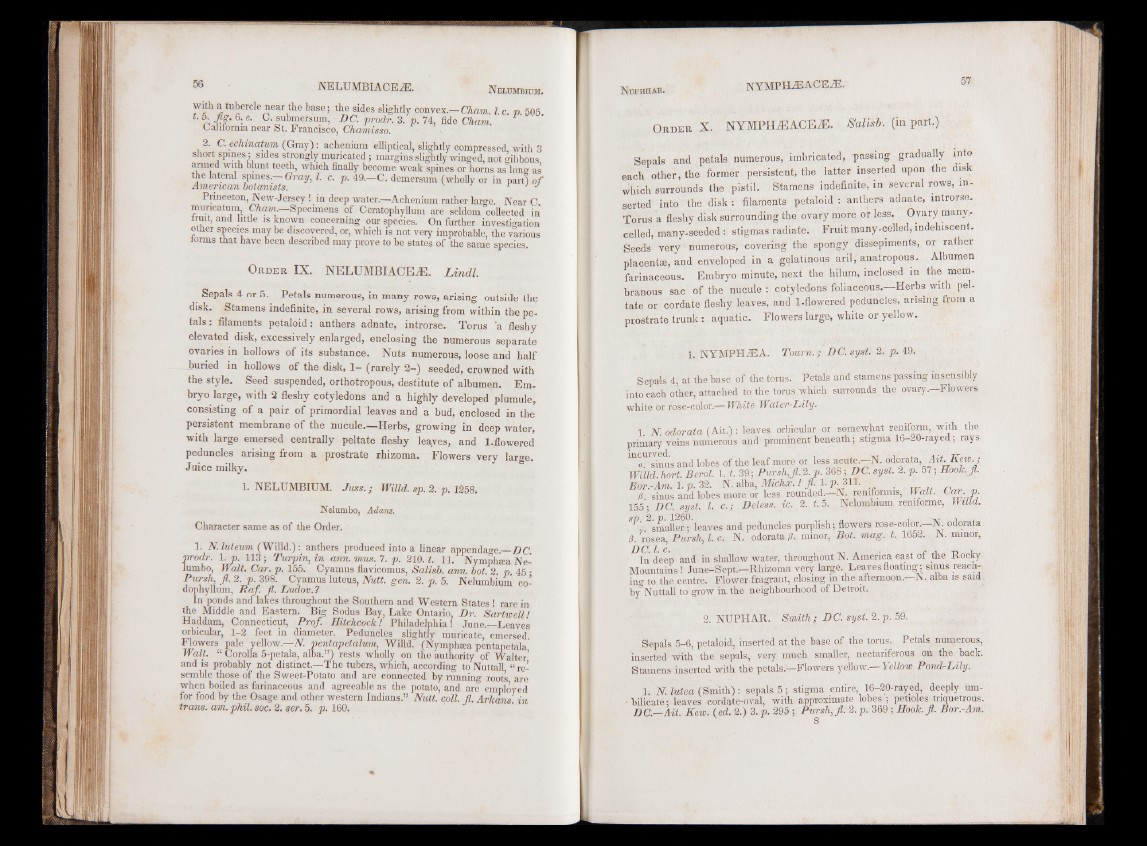
with a tubercle near the base; the sides slightly convex.—Cham. 1. c. p. 505
t. 5. fig . 6. e. C. submersum, DC. prodr. 3. p. 74, fide Cham.
California near St. Francisco, Chamisso.
2. C. echinatum (Gray): achenium elliptical, slightly compressed with 3
short spines ; sides strongly muricated ; margins slightly winged, not gibbous
armed with blunt teeth, which finally become weak spines or horns as long as
the lateral spines. Gray, l. c. p. 49.—C. demersum (wholly or in part) o f
American botanists. v j j
Princeton, New-Jersey ! in deep water.—Achenium rather large. Near C
muncatum, Cham.—Specimens of Ceratophyllum are seldom collected in
iruit, and little is known concerning our species. On further investigation
other species maybe discovered, or, which is not very improbable, the various
iorms that have been described may prove to be states of the same species.
Or d e r IX. NELUMBIACEiE. L in d l.
Sepals 4 or 5. Petals numerous, in many rows, arising outside the
disk. Stamens indefinite, in several rows, arising from within the pe-
tals: filaments petaloid: anthers adnate, introrse. Torus a fleshy
elevated disk, excessively enlarged, enclosing the numerous separate
ovaries in hollows of its substance. Nuts numerous, loose and half
buried in hollows of the disk, 1 - (rarely 2 -) seeded, crowned with
the style. Seed suspended, orthotropous, destitute of albumen. Em-
bryo large, with 2 fleshy cotyledons and a highly developed plumule,
consisting of a pair o f primordial leaves and a bud, enclosed in the
persistent membrane of the nucule.—Herbs, growing in deep water,
with large emersed centrally peltate fleshy leaves, and 1-flowered
peduncles arising from a prostrate rhizoma. Flowers very large.
Juice milky.
1. NELUMBIUM. Juss.; Willd. sp. 2. p. 1258.
Nelumbo, Adans.
Character same as of the Order.
1. N. luteum (Willd.): anthers produced into a linear appendage.—DC.
prodr. l .p . 113; Turpin, in ann.mus. 7. p. 210. t. 11. Nymphsea Nelumbo,
Walt. Car. p. 155. Cyamus flavicomus, Salisb. ann. bot. 2. p. 45 •
Pursh, fl. 2. p. 398. Cyamus luteus, Nutt. gen. 2. p. 5. Nelumbium co-
dophyllum, R a f. ft. Ludov.7
In ponds and lakes throughout the Southern and Western States ! rare in
the Middle and Eastern. Big Sodus Bay, Lake Ontario, Dr. Sartwell'
Haddam, Connecticut, Prof. Hitchcock! Philadelphia! June.—Leaves
orbicular, 1-2 feet in diameter. Peduncles slightly muricate, emersed.
Flowers pale yellow.—N. pentapetalum, Willd. (Nymphsea pentapetala"
Walt. “ Corolla 5-petala, alba.”) rests wholly on the authority of Walter’
and is probably not distinct.—The tubers, which, according to Nuttall “ resemble
those of the Sweet-Potato and are connected by running roots are
when boiled as farinaceous and agreeable as the potato, and are employed
for food by the Osage and other western Indians.” Nutt. coll. fl. Arkans. in
trans. am. phil. soc. 2. ser. 5. p. 160.
Or d e r X . N Y M PH iE A C E iE . S a lisb : (in part.)
Sepals and petals numerous, imbricated, passing gradually into
each other, the former persistent, the latter inserted upon the disk
which surrounds the pistil. Stamens indefinite, in several rows, in-
serted into the disk : filaments petaloid : anthers adnate, introrse.
Torus a fleshy disk surrounding the ovary more or less. Ovary many.-
celled, many-seeded : stigmas radiate. Fruit many-celled, indehiscent.
Seeds very numerous, covering the spongy dissepiments, or rather
placentae, and enveloped in a gelatinous aril, anatropous. Albumen
farinaceous. Embryo minute, next the hilum, inclosed in the membranous
sac o f the nucule : cotyledons foliaceous.— Herbs with peltate
or cordate fleshy leaves, and 1-flowered peduncles, arising from a
prostrate trunk : aquatic. Flowers large, white or yellow.
1. NYMPHiEA. T ow n .; DC. syst. 2. p. 49.
Sepals 4, at the base of the torus. Petals and stamens passing insensibly
into each other, attached to the torus which surrounds the ovary.—Flowers
white or rose-color.— White Water-Lily.
1 N. odorata (A it.): leaves orbicular or somewhat reniform, with the
primary veins numerous and prominent'beneath; stigma 16-20-ray ed; rays
T J k t and lobes of the leaf more or less acute.—N. odorata A it-K e ^ .j
Willd. hort. Berol. 1. t. 39; Pursh,ft. 2. p. 368; DC. syst. 2. p. 57; Hook.fi.
Bor.-Am. 1. p. 32. N. alba, Michx. ! ft. f P ; T311- S n
0 sinus and lobes more or less rounded.—N. remformis, Walt. C a r .p .
155 ; j jc . syst. 1. c.; Deless. ic. 2. t. 5. Nelumbium remforme, Willd.
SP'V smaller; 'leaves and peduncles purplish; flowers rose-color.—N. odorata
0. rosea, Pursh, l. c. N. odorata 0. minor, Bot. mag. t. 1652. N. minor,
DC l c
In deep and in shallow water, throughout N. America east of the Rocky
Mountains ! June-Sept—Rhizoma very large. Leaves floating ; sinus reaching
to the centre. Flower-fragrant, closing in the afternoon.—N. alba is said
by Nuttall to'grow in. the neighbourhood of Detroit.
2. NUPHAR. Smith; DC. syst. 2.p. 59.
Sepals 5-6, petaloid, inserted at the base of the torus. Petals numerous,
inserted with the sepals, very much smaller, nectariferous on the back.
Stamens inserted with the petals.'—Flowers yellow.— Yellow Pond-Lily.
1. N. lutea (Smith): sepals 5; stigma entire, 16-20-rayed, deeply urn-
- bilicate: leaves cordate-oval, with approximate lobes ; petioles triquetrous.
DC.—Ait. Kew. (ed. 2.) 3. p. 295 ; Pursh, fl. 2. p. 369 ; Hook.fl. Bor.-Am.
8